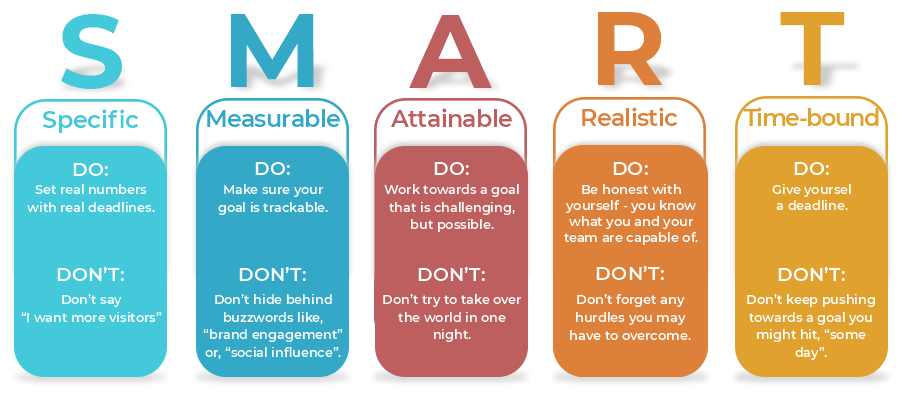Defining Measurable Goals That Align With Your Overall Marketing Objectives
Setting clear and measurable goals is essential for any marketing strategy, as it allows you to track your progress, evaluate the effectiveness of your efforts, and make necessary adjustments along the way. So let's dive in!
First and foremost, it's important to have a clear understanding of your overall marketing objectives as a scientific illustrator. Ask yourself, what do you hope to achieve through your marketing efforts?
As we saw in Module 1, section 3, when you was setting your career goals, a handy tool to keep in mind is the SMART method when it comes to setting your marketing objectives too. It is a popular approach that helps ensure your goals are on point and increase your chances of success.
The SMART goals approach is a framework commonly used as well in marketing and project management to set objectives.
It provides a structured and effective way to define goals that are more likely to lead to success. Let's break down each aspect of SMART:

SPECIFIC
A specific goal is clear and well-defined. It answers the questions of who, what, where, when, and why. Rather than setting a general goal like "increase sales," a specific goal would be "increase contacts by 15% in the next quarter by targeting new customer segments: marine biologists."
MEASURABLE
A measurable goal is one that can be quantified or assessed using concrete data or metrics. It allows you to track progress and determine if you have achieved your objective. For example, instead of setting a vague goal like "Increase website traffic" a measurable goal would be"Increase website traffic by 25% within the next six months through instagram ads."
This goal is measurable because it specifies a quantifiable metric, which is the percentage increase in website traffic. By setting a specific target of 25% and a specific social media platform, it becomes easier to assess the effectiveness of the digital marketing efforts using the social media analytics tools. The timeframe of six months provides a clear deadline for achieving the goal.
ACHIEVABLE
An achievable goal is one that is realistic and attainable based on the available resources, capabilities, and constraints. It's important to set goals that challenge you but are still within reach. For instance, rather than aiming to "dominate the entire market," an achievable goal could be "increase market share by 5% within the next year through targeted marketing campaigns."
REALISTIC
A realistic goal is aligned with your overall business objectives and contributes directly to your marketing strategy. Also the "R" letter stands for relevant. It ensures that your efforts are focused on what matters most to your business. For example, if your business objective is to expand into new geographic markets, a relevant goal might be "increase brand awareness in the target regions by 30% within six months through localized marketing campaigns."
TIME-BOUND
A time-bound goal has a specific timeframe or deadline attached to it. It helps create a sense of urgency and provides a clear target date for completion. Instead of setting an open-ended goal like "improve SEO rankings," a time-bound goal would be "improve SEO rankings to reach the first page of search results for targeted keywords within three months."
By applying the SMART goals approach in your marketing strategy, you ensure that your objectives are well-defined, measurable, realistic, aligned with your overall business goals, and have a clear timeline for completion. This approach helps you stay focused, monitor progress, and make adjustments as needed, ultimately increasing the chances of achieving marketing success.
Creating A Timeline And Action Plan To Accomplish Your Digital Marketing Goals
Here's an example of a timeline and action plan to accomplish your digital marketing goals as a scientific illustrator:
Month 1:
- Conduct a comprehensive website audit to identify areas for improvement, such as website design, user experience, and search engine optimization (SEO).
- Perform keyword research to identify relevant keywords and phrases that your target audience uses to search for scientific illustrations.
- Optimize your website content, including meta tags, headings, and image alt text, based on the identified keywords.
- Set up Google Analytics to track website traffic, user behavior, and conversions.
- Create or update your portfolio section on the website to showcase your best scientific illustrations.
Month 2:
- Develop a content marketing strategy focused on creating informative and engaging blog posts related to scientific illustration.
- Start publishing regular blog posts on your website, incorporating relevant keywords and sharing them on social media platforms.
- Establish a presence on social media platforms such as Instagram, Twitter, and LinkedIn to showcase your work and engage with your target audience.
- Identify and reach out to relevant influencers, bloggers, and scientific communities for collaborations, guest posts, or features.
- Monitor website analytics and social media metrics to assess the impact of your efforts and make necessary adjustments.
Month 3:
- Launch a targeted email marketing campaign to reach out to potential clients, scientific organizations, and researchers who may require scientific illustrations.
- Create a lead magnet, such as a free downloadable guide or infographic, to encourage visitors to subscribe to your email list.
- Regularly send out newsletters or updates to your email subscribers, highlighting your recent works, industry news, or exclusive offers.
- Explore paid advertising options like Google Ads or social media ads to increase your online visibility and drive targeted traffic to your website.
- Engage in online forums and communities related to scientific illustration to establish yourself as an expert and generate leads.
Month 4-6:
- Continuously analyze website and social media analytics to identify top-performing content and channels.
- Refine your content strategy based on the data insights and focus on creating more of the content that resonates with your audience.
- Continuously update your portfolio section with new and high-quality illustrations to showcase your skills and attract potential clients.
- Implement search engine optimization (SEO) strategies such as building backlinks, improving website loading speed, and optimizing mobile responsiveness.
- Monitor and respond to comments, messages, and inquiries across all digital channels promptly to maintain a strong online presence and nurture client relationships.
Conclusion
Remember to review and adjust your digital marketing plan periodically based on the results and feedback you receive. This timeline and action plan should serve as a starting point, but feel free to tailor it to your specific goals and circumstances. Good luck with your digital marketing endeavors as a scientific illustrator!
Create your own action plan. It's important to review it every time you're about to plan the next phases of your marketing strategy. You need to have it clear and top of mind, so put it in a document that's visible on your computer screen or in a PDF file that you can share or view on your mobile phone.

Keep it handy and accessible at all times to stay on track and make sure your marketing efforts are on point.
